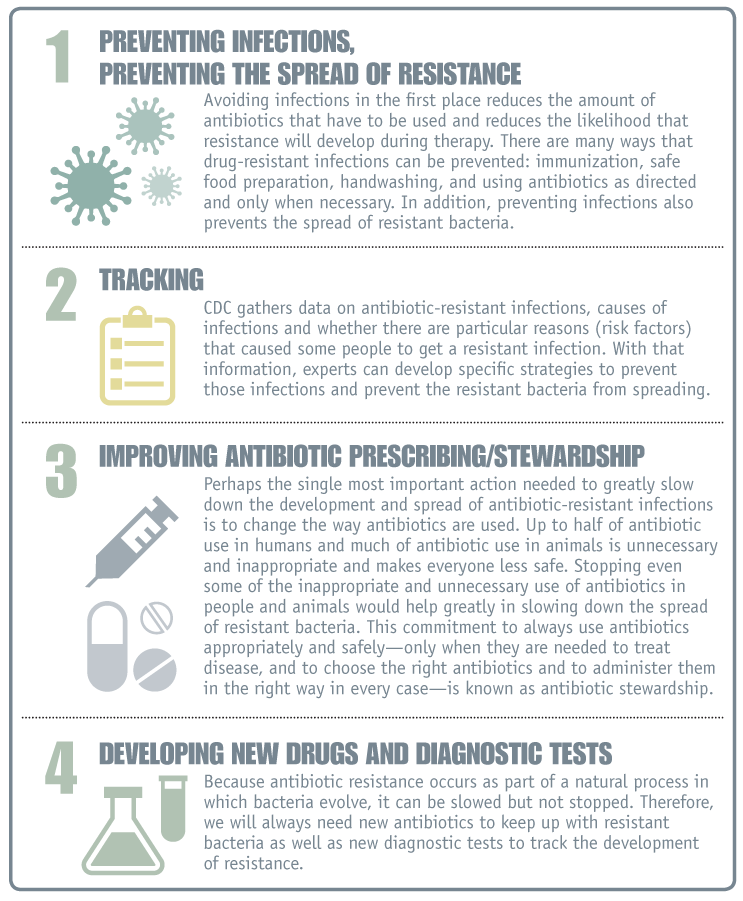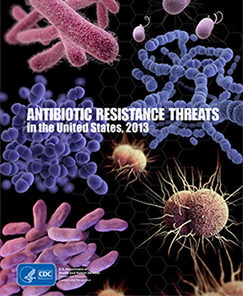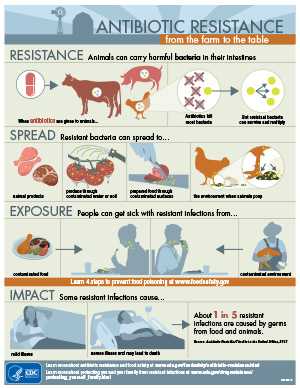Antibiotic Resistance
NARMS Now: Human Data
See how antibiotic resistance for Campylobacter and three other bacteria transmitted commonly through food has changed over the past two decades.
Physicians rely on antibiotics, such as azithromycin and ciprofloxacin, to treat patients with severe Campylobacter infection. However, some infections are resistant to these antibiotics that are commonly used to treat them. Infections with antibiotic-resistant bacteria are often harder to treat, can last longer, and may result in more severe illness. Thus, resistant infections can lead to greater healthcare costs and are a serious threat to public health.
How does antibiotic-resistant Campylobacter spread to people?
Campylobacter can spread from animals to people through contaminated food, especially raw or undercooked chicken. People may also get infected through contact with animals, by drinking raw milk, eating contaminated fresh produce, or drinking contaminated water. International travel increases the chance for infection with resistant Campylobacter. Several studies have shown that infections in people who traveled outside the United States during the week before illness were resistant to ciprofloxacin more often than infections in people who did not travel.
Outbreak Alert
Learn about a multistate outbreak of multidrug-resistant Campylobacter infections linked to contact with pet store puppies
Antibiotics can lead to resistance whenever they are used, whether for animals or for people. Since 1986, fluoroquinolones have been approved for use to treat infections in people. Ciprofloxacin, a fluoroquinolone antibiotic, is used to treat many kinds of infections (including those caused by Campylobacter). In 1995 and 1996, FDA approved fluoroquinolones for use in poultry flocks to control certain infections. In 1990, a CDC survey in selected US counties did not detect ciprofloxacin resistance among a sample of C. jejuni isolates from sick people, but since 1997, when CDC began Campylobacter surveillance in the National Antimicrobial Resistance Monitoring System (NARMS), ciprofloxacin resistance has increased among C. jejuni isolates. The resistance rate subsequently rose from 17% in 1997–1999 to 25% in 2012–2014.
FDA withdrew one fluoroquinolone approval in 2001 and the other in 2005 because of evidence that the use of fluoroquinolones in poultry led to an increase in fluoroquinolone-resistant Campylobacter infections in people. Unfortunately the antibiotic resistance rate did not decrease after the drug was withdrawn from use in poultry.
The high rates of resistance to fluoroquinolones have limited their usefulness in treating Campylobacter infections. Macrolides like azithromycin are the drugs of choice when antibiotic treatment is indicated. Resistance to macrolides is increasing among C. jejuni isolates, although it has remained low, and it is higher among C. coli isolates. In 2014, 27% of C. jejuni and 36% of C. coli isolates were resistant to ciprofloxacin, and 2% of C. jejuni and 10% of C. coli isolates were resistant to azithromycin.
Key measures to prevent resistant Campylobacter infections include:
- Using antibiotics appropriately in people and animals
- Improving sanitation on farms to reduce the spread of Campylobacter
- Implementing disease prevention programs on farms to reduce the need for antibiotics
How is CDC responding to the threat of antibiotic-resistant Campylobacter?
CDC’s measures to curb the spread of antibiotic-resistant Campylobacter include:
- Tracking changes in antibiotic resistance among human specimens through ongoing surveillance to help inform public health policy and action
- Supporting and strengthening local, state, and federal public health surveillance to enhance detection, reporting, and response to antibiotic resistant infections
- Including strategies to support “whole genome sequencing” of Campylobacter isolates from people, retail meat, and food animals
- Promoting initiatives that encourage appropriate antibiotic use in people and food animals
- Determining foods responsible for outbreaks of Campylobacter infections
- Investigating and controlling Campylobacter outbreaks
- Guiding prevention efforts by estimating how much human illness occurs and identifying the sources of infection
- Educating people about how to avoid Campylobacter infections
CDC’s Role in Preventing Antibiotic-Resistant Infections

Antibiotic Resistance Threats in the United States, 2013

- Page last reviewed: October 2, 2017
- Page last updated: October 2, 2017
- Content source:


 ShareCompartir
ShareCompartir
